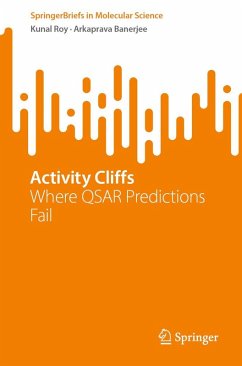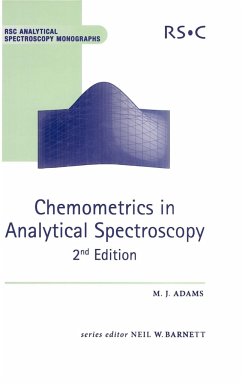
Activity Cliffs
Where QSAR Predictions Fail

PAYBACK Punkte
19 °P sammeln!
This brief introduces the readers of predictive cheminformatics to the concept of cliffs in the structure-activity landscape, which may greatly affect the data set modelability and the quality of predictions, hence generating disappointment from the performance of Quantitative Structure-Activity Relationship (QSAR) models. Although QSAR models are based on the assumption of a smooth activity landscape, where similar molecules are expected to have similar activities, some similar molecules can occasionally exhibit large differences in activity (for example, 100-fold). The definition of similari...
This brief introduces the readers of predictive cheminformatics to the concept of cliffs in the structure-activity landscape, which may greatly affect the data set modelability and the quality of predictions, hence generating disappointment from the performance of Quantitative Structure-Activity Relationship (QSAR) models. Although QSAR models are based on the assumption of a smooth activity landscape, where similar molecules are expected to have similar activities, some similar molecules can occasionally exhibit large differences in activity (for example, 100-fold). The definition of similarity for identifying activity cliffs may be based on chemical fingerprints or descriptors (classical activity cliffs), substructures (chirality cliffs, matched molecular pair cliffs), three-dimensional structure-based cliffs (3D cliffs), or the target-set-dependent potency difference. Some prediction outliers, even within the applicability domain of QSAR models, may arise due to the activity cliff (AC) behavior. In addition to compound pairs, activity cliffs may also be visualized in coordinated networks forming AC clusters. Despite using high-quality data, the data set's modelability may be significantly compromised in the presence of ACs, among other factors. The modelability of the dataset has been studied using different approaches like modelability index (MODI), weighted modelability index (WMODI), rivality index, etc. At the same time, the applicability domain of QSAR models is evaluated using a variety of methods, including leverage, principal components, standardization methods, and distance to the model in X-space, among others. Different methods for identifying activity cliffs have been proposed, such as the structure-activity landscape index (SALI), the structure-activity relationship (SAR) index, and the structure-activity similarity (SAS) maps. Recently, the Arithmetic Residuals in K-Groups Analysis (ARKA) has been shown to be successful in identifyingactivity cliffs. This approach has also been applied in small data set classification modeling. A multiclass ARKA approach has also been developed for its possible application in regression-based problems by integrating it with the quantitative read-across structure-activity relationship (q-RASAR) framework. This book showcases the evolution and the current status of the concept of activity cliffs as relevant to QSAR predictions and indicates the future directions in the research on activity cliffs. Researchers in the fields of medicinal chemistry, predictive toxicology, nanosciences, food science, agricultural sciences, and materials informatics should benefit from the concept of activity cliffs, impacting model-derived predictions.












